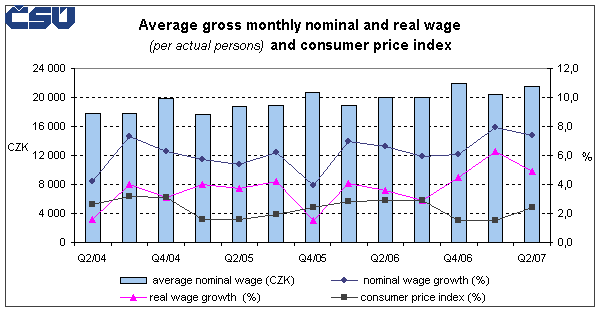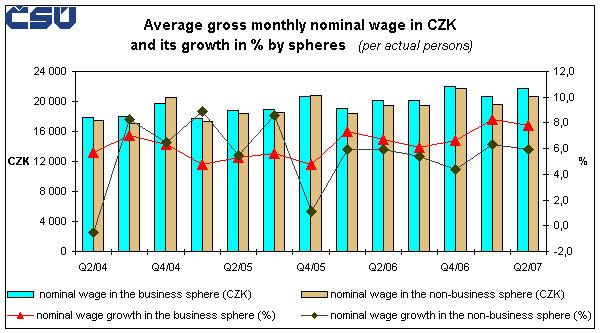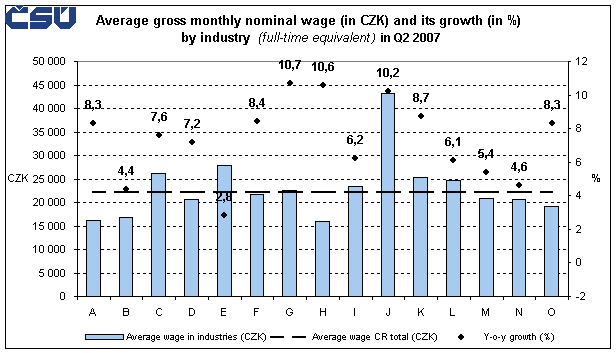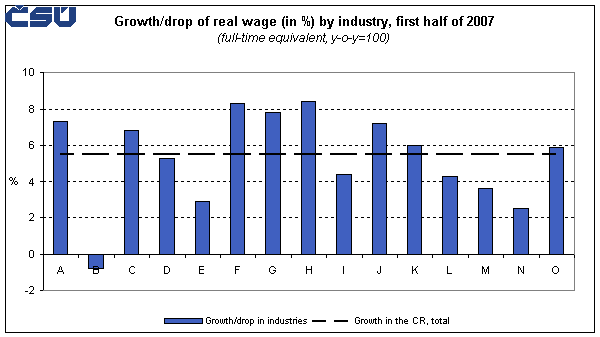Analysis of the development of average wages of employees - 2. quarter of 2007
Product Code: e-3134-07
In Q2 2007, the average gross monthly nominal wage2 per actual person reached CZK 21 462; in the year-on-year comparison the increase was CZK 1 480.
In the business sphere the average wage rose year-on-year by CZK 1 571 to CZK 21 687, while in the non-business sphere it went up by CZK 1 153 to CZK 20 673. The relative increase of the average wage was 7.4%, the growth in the business sphere being 7.8% and in the non-business sphere 5.9%. The relative y-o-y increase of the average nominal wage in Q2 (7.4%) compared to Q1 showed the slow-down of the growth by 0.5 percentage point, however, it ranks among the highest in the last 5 years.
The development of real wage is in addition to the nominal wage growth affected also by the growth of price level (inflation) expressed by the consumer price index. Consumer prices increase in Q2 by 2.4% represented a growth of real wage by 4.9%, in the business sphere by 5.3% and in the non-business sphere by 3.4%. For the development of nominal wage, real wage and the consumer price index see Graph 1, more detailed information on /produkty/pmz_cr.
Graph 1

Minimum wage was increased as of 1 January 2007 up to CZK 8 000, in the first half of 2006 it amounted to CZK 7 570 and in the second half-year to CZK 7 955.
The increase of the volume of wages and sets of reporting units not including enterprises with less than 20 employees, compared to the same period of the previous year, accounted for almost CZK 16.8 bln., which is more than 8.5% at a 0.1% current growth of the number of employees.
Nationwide wage development is heavily shaped primarily by the business sphere as employees of this sphere account for more than three quarters of the set of units measured. While the wage development in the business sphere is more fluent and is affected mainly by economic results of the companies, it is jump-like in nature in the non-business sphere because it depends to a large extent on legislative measures of the government and on what is permitted by the budget. Since 2005, the payment of the so-called other salaries was cancelled in the non-business sphere. Thereby, marked differences in the wage level between individual quarters were suppressed and wage development started to be more fluent. This fact is most clearly documented by year-on-year relative increases since Q1 2006, which is the first from this point of view comparable period in this sphere. The nominal wage development and relative increments by spheres are shown in Graph 2.
Graph 2

In the whole first half of 2007 the average gross monthly nominal wage reached CZK 20 938 which was by CZK 1 485 more, y-o-y. In the business sphere the average wage increased y-o-y by CZK 1 578 rising to CZK 21 174, in the non-business sphere by CZK 1 150 rising to CZK 20 106. The relative increase of the average wage was 7.6% in total, the growth in the business sphere being 8.1%, in the non-business sphere 6.1%.
Consumer prices increased in the reported period by 2.0%, real wage thereby increased by 5.5% in total, in the business and non-business sphere by 6.0% and 4.0%, respectively.
***
Given the fact that the non-business sphere employs a higher proportion of part-time workers than the business one, the following comparisons are made with average wage data related to full-time equivalent (FTE) employees as these data take account of the length of work.
In Q2 2007, the average gross monthly nominal wage per FTE person increased by CZK 1 525 year-on-year (+7.4%) and reached CZK 22 152, in the business sphere the increase was CZK 1 613 (+7.8%) rising to CZK 22 206 and in the non-business sphere to CZK 21 955 (+5.8%, CZK +1 206). Real wage increased, y-o-y, by 4.9% in total, by 5.3% in the business sphere and 3.3% in the non-business sphere.
Differences in the wage level and in its growth rate between industries (CZ-NACE sections) are well characterized by Graph 3. The graph suggests that the lowest wage level in Q2 2007 existed in ‘hotels and restaurants’ (CZK 15 957); ‘agriculture, hunting and forestry’ (CZK 16 070); ‘fishing‘ (CZK 16 790). On the other hand, the highest wage level was reached in ‘financial intermediation‘ (CZK 43 159), ‘electricity, gas and water supply‘ (CZK 27 942), and ‘mining and quarrying‘ (CZK 26 084). The lowest relative year-on-year increase (+2.8%) representing a nominal growth by approximately CZK 800 was recorded in one of industries where the employees receive the highest wages i.e. ‘electricity, gas and water supply‘. In contrast, the highest relative y-o-y increase was recorded in 'wholesale and retail trade; repair of motor vehicles, motorcycles and personal and household goods' (10.7%) and in ‘hotels and restaurants’ (10.6%). This almost equal relative growth should be assigned to the difference in nominal increase of average wage which in previously mentioned industry accounted for approximately CZK 2 200 and in 'hotels and restaurants' CZK 1 500.
Graph 3


When comparing divisions more important from the aspect of employment (employing a minimum of 20 thousand people 3) the comparison at the CZ NACE division level (more detailed classification on a two digit code) suggests that at both ends of imaginative ladder there are in individual reference periods the same industries with more or less stable ranking. For the whole first six months of 2007 the highest nominal average wage was reached in 'financial intermediation except insurance and pension funding' (CZK 49 609), year-on-year rise being 8.1% (+0.5 p.p. compared to nationwide average). In contrast, the lowest nominal average wage was recorded in 'manufacture of textiles and textile products' (CZK 14 484), the y-o-y growth being 7.6% (achieving the nationwide average). However, negligible difference in relative increase means relatively high difference in absolute sum earned in addition, year on year, by employees in the above mentioned industries. While in the first mentioned industry the gross wage increased by approximately CZK 3.7 thousand, in the following industry the employees earned by only CZK 1 000 more.
Other industries where employees receive best wages are the following: 'computer and related activities' (CZK 47 163, y-o-y growth +5.7%, i.e. CZK 2 530) and 'electricity, gas and water supply' (CZK 30 620, y-o-y growth 6.0%, i.e. CZK 1 721). Among industries where employees receive the lowest wages still belong the following: 'agriculture, hunting and related service activities' (CZK 14 851, y-o-y growth 8.3%, i.e. CZK 1 139), 'hotels and restaurants' (CZK 15 645, y-o-y growth 10.6%, i.e. CZK 1 495).
When comparing divisions irrespective of the number of employees the highest nominal wage (division 'air transport' – CZK 55 426) was 4.7times the nominal wage of employees in the industry paying the lowest wage ('manufacture of wearing apparel; dressing and dyeing of fur' - CZK 11 744). Year-on-year, the average wage in the industry paying the highest wage increased by 13.2%, i.e. by almost CZK 6.5 thousand and in the industry paying the lowest wage it increased by 8.0%, i.e. by not even CZK 900. The inter-industry wage differences (per FTE persons) increased year-on-year; the variation coefficient of average wages (by CZ-NACE division) was 0.9 percentage point up and reached 37.4%.
The year-on-year increments of the real wage in the CZ-NACE industries (CZ-NACE sections) compared to the national average are shown in the following graph.
Graph 4


The comparison of the wage development made for sectors suggests that the highest average wages have been paid for a long time in financial institutions, insurance companies and pension funds. In the first six months of 2007 the average wage (per FTE persons) in the financial institutions was 2.1times the national average of which private national institutions (employing approximately 10 thousand persons) paid wages 1.7times the national average and foreign-controlled private institutions (employing about 55 thousand persons) 2.2times the national average. In contrast, average wage of employees in the sector of households (i.e. wages of unincorporated natural persons) reaches approximately 64% of the national average. In the sector of non-profit institutions serving households the wages make about 77% of the average wage in the whole of the CR. The average wage level, though, is fundamentally affected by the non-financial corporations sector and the government sector. Employees of these sectors make up about 95% of the set of units measured.
The average nominal wage in enterprises and organisations, which employ 250+ employees exceeded CZK 23 thousand (per FTE persons), in enterprises with 50-249 employees it reached almost CZK 20 thousand, in enterprises with 20-49 employees the average wage was about CZK 19.5 thousand. It is important to note that the above mentioned statistical data refer to the set of reporting units, which do not include enterprises with less than 20 employees, financial institutions and organizations of non-business sphere irrespective of the number of employees.
1 The data refer to business sphere enterprises with 20+ employees (in financial intermediation irrespective of the number of employees) and all non-business sphere organizations. They only refer to employees under employment contract with reporting units. Persons performing public office, such as members of Parliament, senators, full-time councillors at all levels, judges, etc. are excluded.
2 In this connection it is appropriate to remind what does the average gross monthly wage mean. It concerns the share of wages and salaries (incl. premium pays, directs remunerations and bonuses, refund of wages etc.) per one employee monthly regardless the fact whether this employee has a university degree and responsibility for the operation of the whole company or is a person working in the same company as a blue-collar. From this point of view it does not show, what salary does each concrete employee receive. It is also important to be aware of the fact that an employee receives net salary, while the gross wage is such, from which the employer pays appropriate amounts on health and social insurance, policy of employment and advance income tax. Whether the average gross monthly nominal wage reaches whatever level, it is important to take into account the fact that results of the structural statistics, when data on earnings of individual employees are available state that approximately two thirds of employees have a lower wage than the national average. Currently the CZSO publishes a publication „Structure of Earnings Survey 2006“ providing information not only about the average wage but also about the median level of the gross wage (e.g. by sex, age, employment etc), which reports on the employee wage in the middle of the wage distribution (the publication is available at: /produkty/struktura-mezd-zamestnancu-2006-3phrc73bp3).
3 survey does not include enterprises employing less than 20 persons
